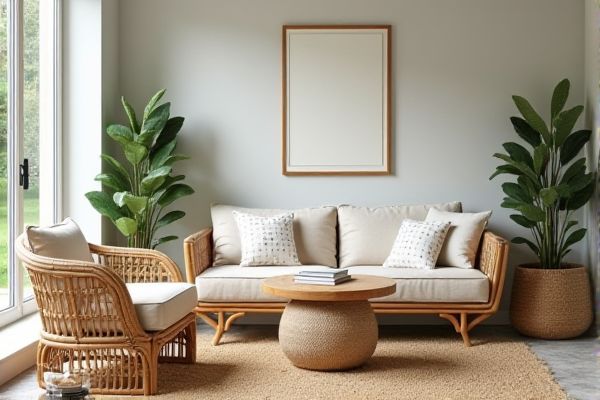
Rattan and wicker differ primarily in material and construction; rattan is a natural vine used as raw material, while wicker refers to the weaving technique applied to various materials, including rattan. Discover how understanding these distinctions can enhance Your choice in stylish and durable furniture by reading the rest of this article.
Table of Comparison
| Feature | Rattan | Wicker |
|---|---|---|
| Material Origin | Natural vine from tropical palm plants | Weaving technique using various materials (rattan, bamboo, synthetic fibers) |
| Durability | Strong, flexible, long-lasting | Varies by material; synthetic wicker is highly durable, natural can be less so |
| Appearance | Smooth, firm texture with natural wood look | Textured weave pattern, can mimic rattan or other materials |
| Usage | Furniture, baskets, decor | Furniture, baskets, outdoor items, decor |
| Maintenance | Requires protection from moisture for longevity | Synthetic wicker is low maintenance; natural wicker needs regular care |
| Cost | Generally higher due to natural sourcing | Varies; synthetic options often more affordable |
Understanding Rattan: Definition and Origins
Rattan is a natural vine-like palm native to tropical regions of Africa, Asia, and Australasia, renowned for its strength and flexibility. It grows as a climbing plant, harvested primarily for its long, slender stems used in furniture and basketry. Understanding rattan's botanical origins is essential to differentiate it from wicker, which refers to the weaving technique rather than the material itself.
What is Wicker? Materials and Techniques
Wicker refers to a weaving technique rather than a specific material, characterized by interlacing pliable plant fibers or synthetic materials into intricate patterns for furniture and baskets. Common materials used in wicker include natural fibers such as rattan, willow, reed, and bamboo, alongside synthetic fibers like resin for enhanced durability and weather resistance. The weaving techniques vary from plain to twill and double-weave patterns, each providing unique strength and aesthetic appeal to the finished product.
Key Differences Between Rattan and Wicker
Rattan refers to a natural climbing palm used as raw material, while wicker is the weaving technique applied to various materials, including rattan, bamboo, or synthetic fibers. Rattan furniture often features sturdy, flexible canes that provide durability, whereas wicker emphasizes the intricate, decorative patterns created through weaving. Understanding that rattan is a specific material and wicker is the craftsmanship distinguishes their applications and aesthetic appeal in furniture design.
Durability: Rattan vs Wicker Furniture
Rattan furniture is made from natural vine material, offering strong durability and flexibility, making it resistant to wear and tear over time. Wicker refers to the weaving technique often applied to rattan, resin, or other synthetic materials, with synthetic wicker typically providing enhanced weather resistance and longevity compared to natural rattan. Choosing between rattan and wicker largely depends on your need for natural aesthetics versus long-lasting outdoor performance.
Aesthetic Appeal: Style and Design Comparisons
Rattan offers a natural, organic aesthetic with smooth, uniform strands ideal for sleek, contemporary furniture designs, while wicker provides a more textured, handcrafted look through intricate weaving patterns that suit traditional or rustic styles. The flexibility of rattan allows for fluid, curved shapes emphasizing modern minimalism, whereas wicker's diverse weaving techniques enable rich visual depth and classic charm. Both materials contribute distinct stylistic elements, with rattan favoring clean lines and wicker delivering artisanal complexity in home decor.
Indoor vs Outdoor Suitability
Rattan is a natural material known for its flexibility and lightweight properties, making it ideal for indoor furniture where it is protected from extreme weather conditions. Wicker refers to the weaving technique that can be applied to various materials, including synthetic fibers designed for outdoor use due to their resistance to moisture, UV rays, and temperature fluctuations. Synthetic wicker furniture is highly durable in outdoor environments, while natural rattan requires indoor placement to maintain its structural integrity and appearance.
Maintenance and Care Tips
Rattan requires regular dusting and occasional wiping with a damp cloth to prevent dirt buildup and maintain its natural flexibility. Wicker, often made from synthetic materials, is more resistant to moisture and can be cleaned with mild soap and water without damage. Both materials benefit from keeping furniture out of direct sunlight and extreme humidity to prolong their lifespan and prevent cracking or brittleness.
Sustainability and Eco-Friendliness
Rattan, derived from fast-growing climbing palms, is a highly sustainable material due to its rapid renewability and minimal environmental impact during harvesting. Wicker refers to the weaving technique rather than a specific material, often incorporating rattan, bamboo, or synthetic fibers, which vary in eco-friendliness depending on their source and production methods. Choosing furniture made from natural rattan offers superior eco-friendly benefits compared to synthetic wicker, as it biodegrades and supports sustainable forestry practices.
Price Comparison: Rattan vs Wicker Cost Factors
Rattan furniture generally costs more due to its durable natural material and labor-intensive harvesting, while wicker varies in price depending on whether it's made from natural fibers or synthetic resin. Synthetic wicker tends to be more affordable and weather-resistant, reducing long-term replacement expenses compared to natural rattan. Your choice between rattan and wicker should consider upfront price differences alongside maintenance and longevity costs.
Choosing the Right Option for Your Home
Rattan offers a natural, durable material ideal for both indoor and outdoor furniture due to its flexibility and strength, while wicker refers to the weaving technique used with different materials, including synthetic fibers that provide weather resistance. Selecting rattan enhances the organic aesthetic and longevity of your furniture, whereas wicker made from synthetic materials requires less maintenance and withstands exposure to the elements better. Consider the environment and usage frequency of your furniture to determine whether the authentic texture of rattan or the practical durability of synthetic wicker best suits your home.
 homyna.com
homyna.com